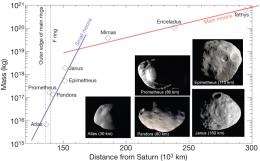June 10, 2010 report
Formation of Saturn's ring moons explained

(PhysOrg.com) -- New computer simulations based on data collected by the Cassini spacecraft mission suggest five of Saturn's moons may have been formed only 10 million years ago, and researchers in France and England think new moons could still be formed because the processes that created the ring moons are still active.
Until now most scientists believed the tiny ring moons, Atlas, Janus, Pandora, Prometheus, and Epimetheus, orbiting the planet just inside or just outside the planet’s rings were formed at the beginning of the solar system some 4.5 billion years ago and were captured by Saturn’s gravity. One problem with this theory is that the tiny moonlets, some of which are under 50 kilometers across, should have been destroyed by comets over time.
If the ring moons had formed at the beginning of the solar system they ought to be similar in density to asteroids, but the data gathered by Cassini shows the density of the moons is under one gram per cubic centimeter, which is far less than asteroid rock. This suggests they did not condense from a primordial disk of dust and gas at all.
One theory of the moons’ formation was that they formed from material in the rings clumping together, but until now no one had been able to develop a computer simulation that could mimic such a process because of the enormous amount of data that would be involved in the numerical model, which would normally need to start at the beginning of the solar system and track each moon’s orbit since then.
Now researchers at the Université Paris Diderot in Paris, France and at the University of Cambridge in the UK have created a simplified model that reduced the ring to one dimension. They tested the model against our own Moon’s formation, and then applied it to Saturn. The model shows the 15,000-km-wide main ring, which lies 120,000 km from the center of the planet, would feed material to the empty region just beyond it, where it could aggregate.
Saturn’s rings are composed of ice crystals and tiny dust particles, and lie just outside the Roche limit, which is the minimum distance an object such as a moon can approach a planet without being smashed by the planet’s gravity. Just beyond the Roche limit the researchers’ computer simulations show the icy ring material can aggregate to form clumps, which can in turn aggregate to form larger clumps that begin to come under the influence of their own gravity and form tiny moonlets and then small moons. As the moons grow bigger Saturn’s gravitational “tide” would then push them outwards.
Astrophysicist Sébastien Charnoz explained that as the simulation proceeds, the aggregates merged to form increasingly larger objects, culminating in tiny moons, just like the ring moons. The model neatly explains why the biggest of the moons lie farthest from the planet, and why the moons lie in the “F-ring,” a dusty ring beyond the A ring. The computer models suggest the F-ring was generated by the tiny moons and moonlets colliding with each other.
Charnoz said the simulation suggests that not all the bodies in the solar system formed over four billion years ago, and the moonlets could have formed as recently as 10 million years ago. It is also quite possible that new moons are forming today, since the process of accretion is still occurring.
The findings are reported in this week's issue of the journal Nature.
More information: The recent formation of Saturn's moonlets from viscous spreading of the main rings, Nature 465, 752-754 (10 June 2010), doi:10.1038/nature09096
© 2010 PhysOrg.com


















